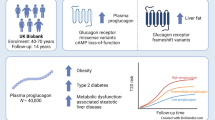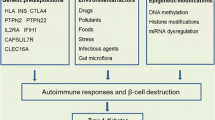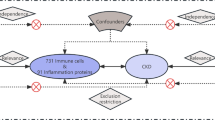Abstract
Hepatocyte nuclear factor 4α (HNF4α) is a transcription factor, which is necessary for normal function of human liver and pancreatic islets. We investigated whether single nucleotide polymorphisms (SNPs) of HNF4A, encoding HNF4α, influenced the conversion from impaired glucose tolerance (IGT) to type 2 diabetes mellitus in subjects of the STOP-NIDDM trial. This trial aimed at evaluating the effect of acarbose compared to placebo in the prevention of type 2 diabetes mellitus. Eight SNPs covering the intragenic and alternate P2 promoter regions of HNF4A were genotyped in study samples using the TaqMan Allelic Discrimination Assays. Three SNPs in the P2 promoter region (rs4810424, rs1884614, and rs2144908) were in almost complete association (D′>0.97, r 2>0.95) and, therefore, only rs4810424 was included in further analyses. Female carriers of the less frequent C allele of rs4810424 had a 1.7-fold elevated risk [95% confidence interval (CI) 1.09–2.66; P=0.020] for the conversion to diabetes compared to women with the common genotype after the adjustment for age, treatment group (placebo or acarbose), smoking, weight at baseline, and weight change. No association was found in men. Haplotype analysis based on three SNPs (rs4810424, rs2071197, and rs3818247) representing the linkage disequilibrium blocks in our study population indicated that the conversion to type 2 diabetes mellitus was dependent on the number of risk alleles in different haplotypes in women. Our results suggest that SNPs of HNF4A and their haplotypes predispose to type 2 diabetes mellitus in female subjects of the STOP-NIDDM study population.
Similar content being viewed by others
References
Parviz F, Matullo C, Garrison WD, Savatski L, Adamson JW, Ning G, Kaestner KH, Rossi JM, Zaret KS, Duncan SA (2003) Hepatocyte nuclear factor 4alpha controls the development of a hepatic epithelium and liver morphogenesis. Nat Genet 34:292–296
Rhee J, Inoue Y, Yoon JC, Puigserver P, Fan M, Gonzalez FJ, Spiegelman BM (2003) Regulation of hepatic fasting response by PPARgamma coactivator-1alpha (PGC-1): requirement for hepatocyte nuclear factor 4alpha in gluconeogenesis. Proc Natl Acad Sci U S A 100:4012–4017
Wang H, Maechler P, Antinozzi PA, Hagenfeldt KA, Wollheim CB (2000) Hepatocyte nuclear factor 4alpha regulates the expression of pancreatic beta-cell genes implicated in glucose metabolism and nutrient-induced insulin secretion. J Biol Chem 275:35953–35959
Stoffel M, Duncan SA (1997) The maturity-onset diabetes of the young (MODY1) transcription factor HNF4alpha regulates expression of genes required for glucose transport and metabolism. Proc Natl Acad Sci U S A 94:13209–13214
Bartoov-Shifman R, Hertz R, Wang H, Wollheim CB, Bar-Tana J, Walker MD (2002) Activation of the insulin gene promoter through a direct effect of hepatocyte nuclear factor 4 alpha. J Biol Chem 277:25914–25919
Fajans SS, Bell GI, Polonsky KS (2001) Molecular mechanisms and clinical pathophysiology of maturity-onset diabetes of the young. N Engl J Med 345:971–980
Ghosh S, Watanabe RM, Hauser ER, Valle T, Magnuson VL, Erdos MR, Langefeld CD, Balow J Jr, Ally DS, Kohtamaki K, Chines P, Birznieks G, Kaleta HS, Musick A, Te C, Tannenbaum J, Eldridge W, Shapiro S, Martin C, Witt A, So A, Chang J, Shurtleff B, Porter R, Boehnke M et al (1999) Type 2 diabetes: evidence for linkage on chromosome 20 in 716 Finnish affected sib pairs. Proc Natl Acad Sci U S A 96:2198–2203
Permutt MA, Wasson JC, Suarez BK, Lin J, Thomas J, Meyer J, Lewitzky S, Rennich JS, Parker A, DuPrat L, Maruti S, Chayen S, Glaser B (2001) A genome scan for type 2 diabetes susceptibility loci in a genetically isolated population. Diabetes 50:681–685
Silander K, Mohlke KL, Scott LJ, Peck EC, Hollstein P, Skol AD, Jackson AU, Deloukas P, Hunt S, Stavrides G, Chines PS, Erdos MR, Narisu N, Conneely KN, Li C, Fingerlin TE, Dhanjal SK, Valle TT, Bergman RN, Tuomilehto J, Watanabe RM, Boehnke M, Collins FS (2004) Genetic variation near the hepatocyte nuclear factor-4 alpha gene predicts susceptibility to type 2 diabetes. Diabetes 53:1141–1149
Love-Gregory LD, Wasson J, Ma J, Jin CH, Glaser B, Suarez BK, Permutt MA (2004) A common polymorphism in the upstream promoter region of the hepatocyte nuclear factor-4 alpha gene on chromosome 20q is associated with type 2 diabetes and appears to contribute to the evidence for linkage in an Ashkenazi Jewish population. Diabetes 53:1134–1140
Weedon MN, Owen KR, Shields B, Hitman G, Walker M, McCarthy MI, Love-Gregory LD, Permutt MA, Hattersley AT, Frayling TM (2004) Common variants of the hepatocyte nuclear factor-4alpha P2 promoter are associated with type 2 diabetes in the U.K. population. Diabetes 53:3002–3006
Bagwell AM, Bento JL, Mychaleckyj JC, Freedman BI, Langefeld CD, Bowden DW (2005) Genetic analysis of HNF4A polymorphisms in Caucasian-American type 2 diabetes. Diabetes 54:1185–1190
Damcott CM, Hoppman N, Ott SH, Reinhart LJ, Wang J, Pollin TI, O’Connell JR, Mitchell BD, Shuldiner AR (2004) Polymorphisms in both promoters of hepatocyte nuclear factor 4-alpha are associated with type 2 diabetes in the Amish. Diabetes 53:3337–3341
Hansen SK, Rose CS, Glumer C, Drivsholm T, Borch-Johnsen K, Jorgensen T, Pedersen O, Hansen T (2005) Variation near the hepatocyte nuclear factor (HNF)-4alpha gene associates with type 2 diabetes in the Danish population. Diabetologia 48:452–458
Vaxillaire M, Dina C, Lobbens S, Dechaume A, Vasseur-Delannoy V, Helbecque N, Charpentier G, Froguel P (2005) Effect of common polymorphisms in the HNF4alpha promoter on susceptibility to type 2 diabetes in the French Caucasian population. Diabetologia 48:440–444
Malecki MT, Antonellis A, Casey P, Ji L, Wantman M, Warram JH, Krolewski AS (1998) Exclusion of the hepatocyte nuclear factor 4alpha as a candidate gene for late-onset NIDDM linked with chromosome 20q. Diabetes 47:970–972
Winckler W, Graham RR, de Bakker PI, Sun M, Almgren P, Tuomi T, Gaudet D, Hudson TJ, Ardlie KG, Daly MJ, Hirschhorn JN, Groop L, Altshuler D (2005) Association testing of variants in the hepatocyte nuclear factor 4alpha gene with risk of type 2 diabetes in 7,883 people. Diabetes 54:886–892
Chiasson JL, Gomis R, Hanefeld M, Josse RG, Karasik A, Laakso M (1998) The STOP-NIDDM Trial: an international study on the efficacy of an alpha-glucosidase inhibitor to prevent type 2 diabetes in a population with impaired glucose tolerance: rationale, design, and preliminary screening data. Study to Prevent Non-Insulin-Dependent Diabetes Mellitus. Diabetes Care 21:1720–1725
Chiasson JL, Josse RG, Gomis R, Hanefeld M, Karasik A, Laakso M (2002) Acarbose for prevention of type 2 diabetes mellitus: the STOP-NIDDM randomised trial. Lancet 359:2072–2077
Lehto M, Bitzen PO, Isomaa B, Wipemo C, Wessman Y, Forsblom C, Tuomi T, Taskinen MR, Groop L (1999) Mutation in the HNF-4alpha gene affects insulin secretion and triglyceride metabolism. Diabetes 48:423–425
Shih DQ, Dansky HM, Fleisher M, Assmann G, Fajans SS, Stoffel M (2000) Genotype/phenotype relationships in HNF-4alpha/MODY1: haploinsufficiency is associated with reduced apolipoprotein (AII), apolipoprotein (CIII), lipoprotein(a), and triglyceride levels. Diabetes 49:832–837
Thomas H, Jaschkowitz K, Bulman M, Frayling TM, Mitchell SM, Roosen S, Lingott-Frieg A, Tack CJ, Ellard S, Ryffel GU, Hattersley AT (2001) A distant upstream promoter of the HNF-4alpha gene connects the transcription factors involved in maturity-onset diabetes of the young. Hum Mol Genet 10:2089–2097
Odom DT, Zizlsperger N, Gordon DB, Bell GW, Rinaldi NJ, Murray HL, Volkert TL, Schreiber J, Rolfe PA, Gifford DK, Fraenkel E, Bell GI, Young RA (2004) Control of pancreas and liver gene expression by HNF transcription factors. Science 303:1378–1381
Wolfrum C, Besser D, Luca E, Stoffel M (2003) Insulin regulates the activity of forkhead transcription factor Hnf-3beta/Foxa-2 by Akt-mediated phosphorylation and nuclear/cytosolic localization. Proc Natl Acad Sci U S A 100:11624–11629
Andrulionyte L, Zacharova J, Chiasson JL, Laakso M (2004) Common polymorphisms of the PPAR-gamma2 (Pro12Ala) and PGC-1alpha (Gly482Ser) genes are associated with the conversion from impaired glucose tolerance to type 2 diabetes in the STOP-NIDDM trial. Diabetologia 47:2176–2184
Zacharova J, Chiasson JL, Laakso M (2005) The common polymorphisms (single nucleotide polymorphism [SNP] +45 and SNP +276) of the adiponectin gene predict the conversion from impaired glucose tolerance to type 2 diabetes: the STOP-NIDDM trial. Diabetes 54:893–899
Weiss LA, Pan L, Abney M, Ober C (2006) The sex-specific genetic architecture of quantitative traits in humans. Nat Genet 38:218–222
Barroso I, Luan J, Middelberg RP, Harding AH, Franks PW, Jakes RW, Clayton D, Schafer AJ, O’Rahilly S, Wareham NJ (2003) Candidate gene association study in type 2 diabetes indicates a role for genes involved in beta-cell function as well as insulin action. PLoS Biol 1:13
Acknowledgement
The STOP-NIDDM trial and DNA analysis were funded by an unrestricted grant from Bayer AG to M. L.
Author information
Authors and Affiliations
Consortia
Corresponding author
Additional information
The first two authors contributed equally to this work.
Members are listed in a previous article published in the Lancet (2002 359: 2072–2077).
Rights and permissions
About this article
Cite this article
Andrulionytė, L., Laukkanen, O., Chiasson, JL. et al. Single nucleotide polymorphisms of the HNF4α gene are associated with the conversion to type 2 diabetes mellitus: the STOP-NIDDM trial. J Mol Med 84, 701–708 (2006). https://doi.org/10.1007/s00109-006-0063-3
Received:
Accepted:
Published:
Issue Date:
DOI: https://doi.org/10.1007/s00109-006-0063-3




